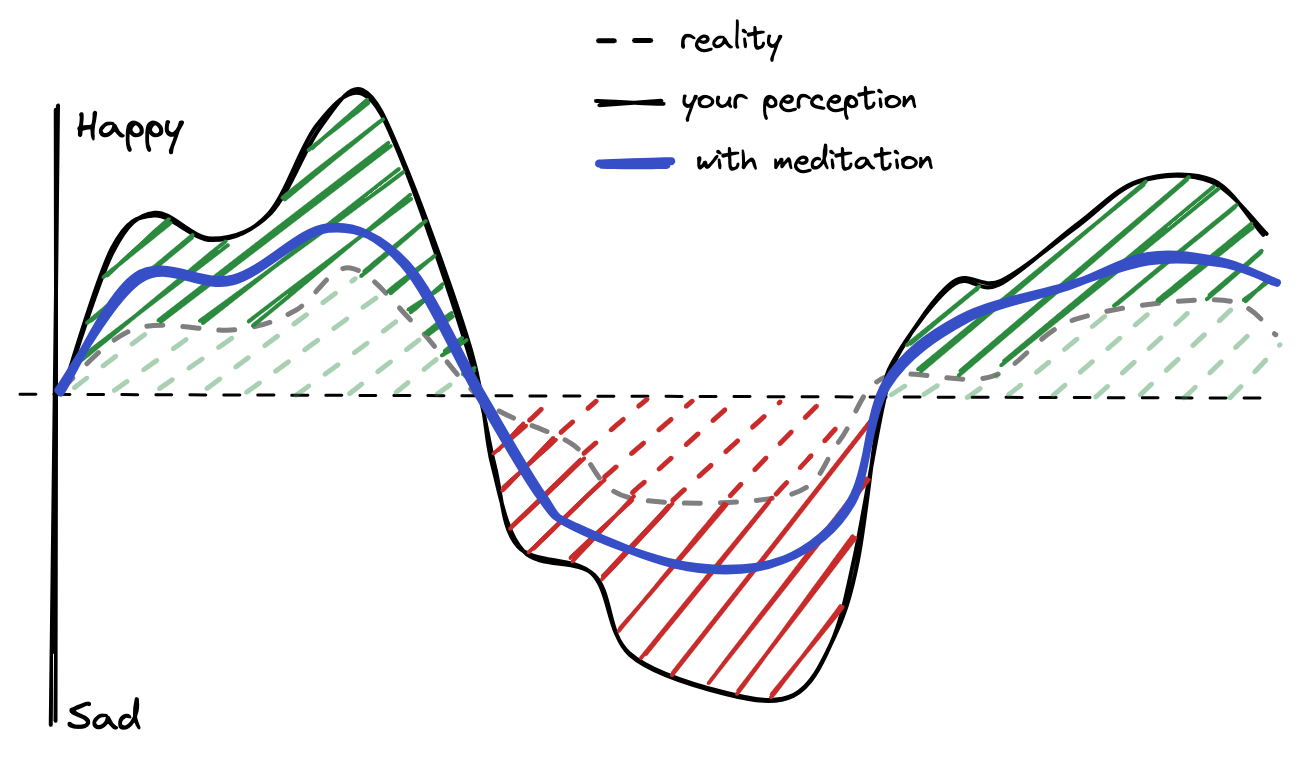What’s the secret to a stable, long lasting happiness that pervades your every moment? Bringing serenity, calm and joy to even the smallest of pleasures? I haven’t got a clue. Happiness is a phantom, in a house of smoke and mirrors. The eminent domain of charlatans and snake oil. The more you chase happiness the more elusive it becomes. But I find myself happy more often than not and it doesn’t feel like an accident. There must be something concrete we can say about it. We should approach the subject with some caution, sneaking up on it from the edges. Happiness can dissipate under our scrutiny, making it all the harder to study.
I haven’t always been happy. If it’s true our default happiness level is set by our genetics then mine is below the average. The black dog didn’t follow me, it sat on my chest and farted in my face. When happiness did arrive it was brief and desperate. I was a shipwreck survivor clinging to the emotional flotsam for dear life. As soon as you notice how perilous your state of happiness is it vanishes. Consumed by a bittersweet anxiety. Things have changed. I’m no longer drowning in a sea of indifference, but have clambered onto a desert island. It’s not paradise, it still weathers a storm or two, but it’s a lot better than it was. Something has changed, and this will be our avenue of attack into the problem of happiness.
The Graph
Before we get there though we must build a mental model of our emotions. Proceeding without one would be fruitless. The set of emotions is a vast, complex, interlocking puzzle of innumerable factors. Our model will be a simplification of reality. But with a purpose of gaining insight without getting bogged down in the details.
Let us imagine the emotional state as a graph over time. The top of the y-axis will be how happy you are and the bottom will be how sad you are. The x-axis will be time, and also delineate the border between happiness and sadness.

There are no numbers on this graph. We are more interested in the relative changes in the graph. Big changes equal big emotions. If I give you a £5 note, your graph shoots up. if I give you another one, it still goes up but not quite as much. Multiple wins have diminishing returns.

If only the same were true of sadness. A string of bad luck can push the line down further than you previously thought possible. The relationship between happiness and sadness isn’t symmetric. You can feel a much deeper sadness than you can happiness.

We can also project into the future and define our ideal graph. That elusive state of steady happiness. We’d want to compress the peaks of the graph, avoiding the lowest of lows but also the highest of highs. We should aim to elevate the baseline, so that we handle small setbacks with ease. We’d also like some defenses against the worst that life can throw at us. It looks something like this.

Defending Happiness
Humans are loss averse. The pain of losing £100 is about 2.5 times more powerful than the joy of gaining £100. This loss aversion is a central piece of our quest for happiness. Sadness is both deeper and more impactful than happiness. Because of this, we will look to defend against sadness rather than seek happiness.
If you’re like me, when the good times come you can’t help but feel that they aren’t going to last. The sudden awareness that you’re having a good time precipitates its demise.

Those high points can be far and few between during a run of bad luck. Or a global pandemic. The more precious they feel the more vulnerable they become. The graph enters the dreaded yo-yo phase.

Let’s start manipulating the graph and see if we can’t help defend happiness.
Meditation
You want to avoid the lowest of lows and also the highest of highs. These extremes cause all sorts of problems. Dizzying heights lead to terrifying crashes. Remember the asymmetry of the relationship between happy and sad. A few peaks are not worth the crushing sadness. It would be better to have a more stable state.
Reality is more mundane than our emotional narrative would let us believe. It creates a graph skewed by our perception. Peaks and troughs go well past our actual experience.

Meditation is the tool you use to reduce this effect. Squeezing the graphs highs and lows together and bringing them closer to the truth.

The opposite effect is also true. It’s possible that things seem duller than they are. A lack of presence in our lives leads to a coasting through with neither good or bad. Missing out on what makes the experience of life important. Meditation brings us back to the present moment.

Meditation is how your train yourself to meet reality where it’s at. It’s a simple and as complicated as sitting in silence. You can start with as little as ten minutes each day.
Diet & Exercise
A healthy diet and moderate exercise are going to produce two desirable effects on our graph. It’s going to limit our downside, capping how bad a crisis feels. And it’s going to produce a positive pressure on the graph. Meaning that with all things being equal we will tend to trend towards happiness.

When you get your diet and exercise right you feel good. A poor quality diet causes anxiety and depression. Exercise is one of the best non medicine interventions for both. There are no zero days when you stay on track, you’ve always achieved something. It’s a pretty big achievement getting the basics right. It can be a huge struggle.
People have made both topics complex so they can sell you a solution you don’t need. Let’s break it down into easy pieces.
Diet
- Eat vegetables. A lot of them.
- Avoid red meat, sugar, grains and ‘processed’ foods.
- Fish and white meat are okay, but not with every meal.
- Reduce dairy intake.
- Use legumes & nuts to supplement your intake.
- Skip breakfast.
Exercise
- Be default active. Walk to the shops. Take the stairs. Stand up.
- There are more fun options than going to a 24/7 gym, explore them.
- Lifting heavy things, when done right, is time efficient and effective.
- People who like running are freaks of nature. If you aren’t one of them, don’t feel bad, do something else
- Start small. Ten minutes a day you finish is better than one hour a week you never start.
It’s best to keep things varied. The loose parameters above give a lot of room that many diet & exercise regimes lack. A variety of stimuli keeps your body in a state of constant adaptation, it’s preferred state. Modern day comfort has lead to stasis, and a host of modern day problems.
Finances
Poor finances have the opposite effect on the graph to diet and exercise. Money worries create a low level stress that never ceases. It limits how happy you can feel and puts a negative pressure on the line. A lack of money equates to a lack of immediate safety. It paralyses the mind into a survival only state.

Without a stable financial base happiness can not flourish. This is true even of hippies and vagabonds. Their lifestyle has reduced their need for money to such a low point their financial need is always met. I like the affordances that a more traditional life affords you. The house, a coffee machine, a memory foam mattress. But that doesn’t mean we shouldn’t take a few cues from our ruffian friends.
Debt is the worst sort of stress. It multiplies your exposure to negative events. A broken leg is bad. If your in considerable debt, it’s a disaster. If there was a pill you could take to make you feel anxious and awful, they would make it from the feeling of debt.
In the defence of happiness, financial security is of the highest priority. Let’s get started right away:
- Pay down any and all debts
- Get out last months bank statement and total up what you spent on what. Be more granular than “Food”. How much did you spend on “crisps”, “alcohol”, “snacks”, “vegetables”? This exercise reveals the truth of your priorities. Did they match your expectations?
- Cut or reduce expenditure in every category that surprised or upset you
- Suspend any major purchase decisions until you’ve saved at least six months of expenses. This is your emergency fund.
With these basics in place you are resilient to bad things in a way you were not before. But you are also exposed to opportunity. With six months expenses in the bank you now have options you didn’t have before. Change career. Pursue a business. Take a break.
It’s no overnight fix, but it will change your life.
Sleep
This needs no explanation or graph.
Get high quality and consistent sleep.
No amount of time, energy or money is too much in the pursuit of good sleep.
Stop killing yourself.
The Right Environment
When the going gets tough we often let our environment slip. Dishes go undone. Beds unmade. Clothes unwashed. What is easy becomes very hard indeed. This puts incredible negative pressure on to the graph. Which ends up looking something like this:

Getting back to clean and organised is going to take some pain. When your emotional state is low you aren’t going to feel like cleaning. But if you never get it sorted, it will trap you in the doldrums.
The irony of course, is that maintenance of a clean environment takes little effort. Go through the pain of getting on top of things once, and replace the large effort with small, daily tasks. A little routine in life provides a structure to it. With a structure in place, more interesting things can begin to accumulate.
The aim is a slow gradual rise in the expectation that you set of yourself. There is no reward for making your bed, no praise for doing the dishes. You must do these things. Honour them as necessities for happiness. There is joy in knowing that you are competent and calm from knowing that you handled all that you need to do.
Keeping Track
The same loss aversion principle we discussed earlier leaves us with a warped memory of our life. Write down five good things that happened yesterday. Now write down five bad things that happened yesterday. Which one was easier? It was the bad things.
This is how our week actually looked:

This is what we remember:

Woops!
The solution is to start keeping track. Capturing the good times as they happen so they don’t fade away. Here’s how I do it:
- Writing in a daily journal
- My Tiny Steps Log
- Telling others about the best parts of my day
It’s not going to change your recall. All the minor annoyances and trifles will still be the first thing that comes to mind. But it will give you some touchstones to remembering the good things that happen all around. Happiness is everywhere when you start noticing it.
Losing your Identities
Who are you? Are you a father? A sports lover? A hard worker? A plant lover? Funny? Dog walker? Wine drinker? Patient? Short tempered? Easy to please? Hard to love? Anxious? Nervous? Depressed? Melancholic? Tired? Bored?
You are a big bag of identities. A few are true. The rest we picked up along the way. Someone told you that you were grumpy once and you’ve been carrying it around ever since. You’ve described yourself as anxious for so long you forget the original reason for your anxiety. We have become over eager to give everything a label. Our endless need to pigeonhole our experience has caused us to start drawing the graph in advance, rather than let life play out.
Depression isn’t solved by saying to yourself “I’m not a depressed person any more”. That is absurd. But you can develop a strong tie to an identity of being a depressed person. Before your experience takes place, you’ve already, in some part of you, decided what the graph is going to look like.

When you then have that experience you’ve already anchored them to your previous prediction of reality. Remember this happens deep in our subconscious. I’m not implying that anyone decided to go to the birthday party and be miserable. It’s much more subtle than that.

When you’ve got a big problem in life, finding a name or identity for it can be a big step. Acknowledging your depression/anxiety/fatigue/melancholy out loud to the world liberates you from years of hiding it away. Without open and honest acknowledgement there can be no change.
But that identity is a tool. It is there to open you to recovery and begin a journey. Some people may never shake the underlying cause of it, and have to find a way to deal with it on their own terms. But this shouldn’t be our default goal. There can and does exist a path forward that frees people from depression/anxiety/sadness. But while you hold on to the identity you’ll never allow yourself to go through the necessary changes. Put down the bag for a little while and see how it feels. Change the way you describe yourself. Not externally but internally as well. What if you had a different identity?
What if you had no identity at all?
Conclusion
This is by no means meant to be a conclusive list or field manual for living a happy life. Only experience can describe happiness, not thoughts and words. That isn’t to say that there are basics that need to be in place for it to flourish. Consider this article and its tools fertiliser for the field. You’ll still have to weather a few storms along the way, but the ground is ready to sprout back to life.
Life is, well, complicated. Use a tool as much as it serves you, and with its limitations in mind. When it comes to your happiness there is one thing that beats out all the conjecture and snake oil - empirical data. Try things, use them, do them, discard them, embrace them. Don’t chase the highs nor avoid the lows. Be still, be present, and keep going.